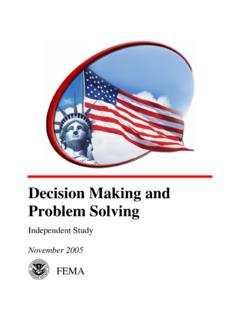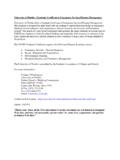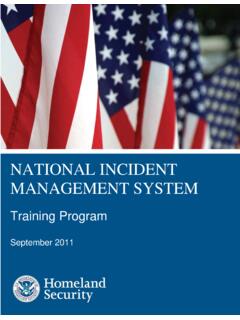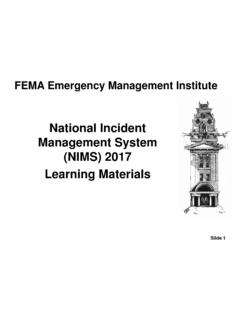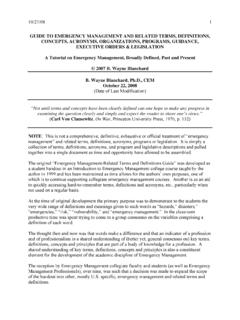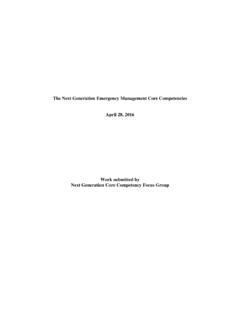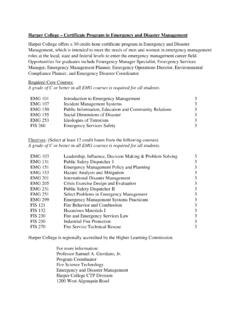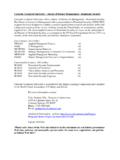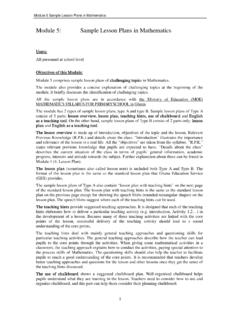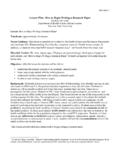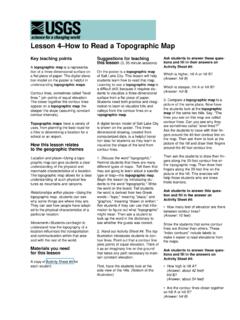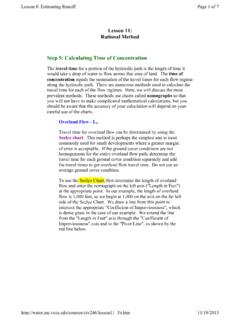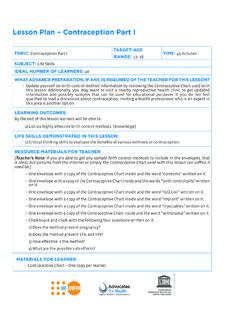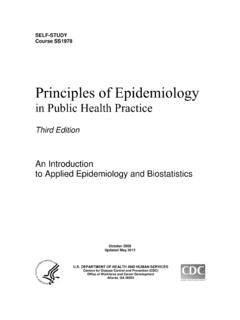Transcription of Lesson 3. Communicating in an Emergency
1 Lesson 3. Communicating IN AN Emergency This page intentionally left blank. Lesson 3. Communicating in an Emergency Effective Communication ( ) February 2014 Student Manual Page INTRODUCTION Visual Key Points This Lesson presents strategies for Communicating effectively in Emergency situations. Lesson 3. Communicating in an Emergency Effective Communication ( ) Page Student Manual February 2014 INTRODUCTION Visual Key Points Transcript: During an incident, communication with the community becomes especially critical.
2 Emergency communications may include alerts and warnings; directives about evacuation, curfews, and other self-protective actions; and information about response status, family members, available assistance, and other matters that impact response and recovery. Well-conceived and effectively delivered Emergency messages can help ensure public safety, protect property, facilitate response efforts, elicit cooperation, instill public confidence, and help families reunite. The extent to which people respond to a warning message is influenced by many factors, including individual characteristics and perceptions, whether the message comes from a credible source, how the message is delivered, and the message itself.
3 You have many communication tools to choose from, including in-person events, print and broadcast media, and Internet and social media. Each has advantages and limitations depending on your communication objective and the intended audience. Whatever communication tools you use, be sure your Emergency communications are clear, contain specific and adequate information, are in sync with other information being disseminated, and are accessible to the whole community. Lesson 3. Communicating in an Emergency Effective Communication ( ) February 2014 Student Manual Page INTRODUCTION Visual Key Points At the completion of this Lesson , you should be able to: Indicate how day-to-day communication differs from communication during an incident.
4 Identify strategies for Communicating effectively in an Emergency situation. Select the most appropriate form of communication for a given situation. Indicate how social media and other communications technology can be used to communicate with members of the community. Lesson 3. Communicating in an Emergency Effective Communication ( ) Page Student Manual February 2014 DELIVERING EFFECTIVE Emergency COMMUNICATIONS Visual Key Points Delivering effective Emergency communications is an essential part of Emergency management.
5 This Lesson presents information about three aspects of Communicating in an Emergency : Emergency Communication Challenges Emergency Communication Tools Creating Effective Emergency Communications Let s begin with the importance of Emergency communication and the challenges it presents. Lesson 3. Communicating in an Emergency Effective Communication ( ) February 2014 Student Manual Page Emergency COMMUNICATION CHALLENGES Visual Key Points Studies show that during an incident, information is as critically important to people as food or water.
6 Not only can accurate information mean the difference between life and death, it can provide reassurance that response and recovery are truly underway. Lesson 3. Communicating in an Emergency Effective Communication ( ) Page Student Manual February 2014 Emergency COMMUNICATION CHALLENGES Visual Key Points Public information during an incident serves many important functions. It can: Save lives and reduce injury. Knowing the proper protective actions to take enables people to reduce their risk. Protect property and the environment.
7 Understanding how to mitigate risk to property and the environment may lessen the damage inflicted by disasters. Facilitate the tactical response by calming fears and managing expectations. People who know what to expect are more likely to follow instructions and allow responders to do their jobs. Educate, inform, and change behavior and attitudes. An educated public is more likely to prepare for emergencies and be ready when they occur. Seek the public s cooperation. Whether the need is for volunteers to help with sandbagging, citizens to cooperate with investigators, or residents to evacuate their homes, public information is an instrument that can help make it happen.
8 Instill public confidence. Providing timely, accurate, and understandable information builds confidence in Emergency management s competence. Provide information to help families reunite. Public information about shelter message boards, hotlines, survivor registries, and other linkages can help reunite families and enable them to move forward with their recovery. Lesson 3. Communicating in an Emergency Effective Communication ( ) February 2014 Student Manual Page Emergency COMMUNICATION CHALLENGES Visual Key Points Emergency communications differ from routine communications in several ways: Barriers: It is more difficult for people to hear messages during an Emergency .
9 Stress, change of routine, and lack of sleep all can be hurdles to overcome when Communicating during emergencies. Timeliness: If official answers are not available, rumor and speculation quickly fill the information vacuum. Then, not only must you disseminate correct information, but you also need to counter any misinformation that circulated. To use media in a timely fashion, learn local media news cycles and deadlines. For example, if a news event occurs at 4:00 , you can most likely get it on the radio immediately, on television in time for the evening report, and into the next morning s edition of the local paper.
10 Online news outlets can be updated at any time. Required Response: Emergency warnings differ from other kinds of messages because their purpose is to elicit a specific response from the public, rather than merely raise awareness or provide knowledge. Lesson 3. Communicating in an Emergency Effective Communication ( ) Page Student Manual February 2014 Emergency COMMUNICATION CHALLENGES Visual Key Points Successful warnings are those that are taken seriously and responded to in a timely and effective manner. Multiple factors may have an impact on whether people respond to a warning, including: Individual characteristics Age, education, language, access and functional needs, family composition, and length of residency, among others.
